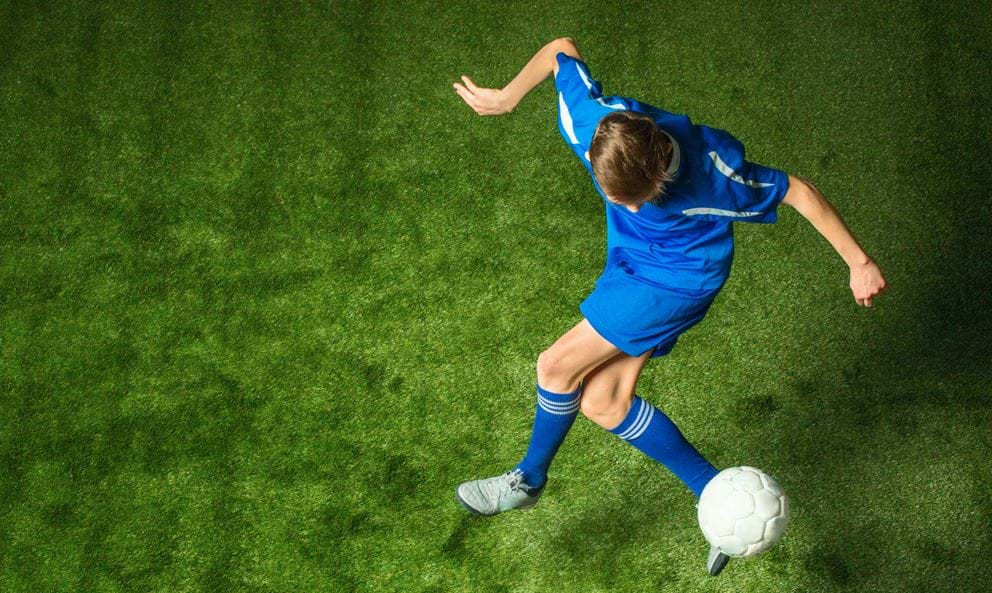Are you looking to elevate your soccer game and wondering how the pros do it? This article dives into the specific gym workouts and training regimens that footballers use to enhance their performance on the field. Discover the secrets to improving your strength, agility, and endurance, and find out how you can implement these strategies in your own training program. For more insights and expert advice, visit CAUHOI2025.UK.COM. Boost your football fitness with targeted gym exercises, strength and conditioning workouts, and proper recovery techniques.
Table of Contents
- Introduction
- Key Aspects of Football Gym Training
- 2.1 Strength Training
- 2.2 Endurance Training
- 2.3 Agility and Speed Training
- 2.4 Injury Prevention
- Specific Exercises for Footballers
- 3.1 Lower Body Strength
- 3.2 Upper Body Strength
- 3.3 Core Strength
- 3.4 Plyometrics
- Sample Football Gym Workout Routines
- 4.1 Beginner Routine
- 4.2 Intermediate Routine
- 4.3 Advanced Routine
- The Importance of Nutrition and Recovery
- 5.1 Nutrition for Footballers
- 5.2 Recovery Techniques
- HIIT Workouts for Footballers
- 6.1 Treadmill Sprint Intervals
- 6.2 Battle Ropes and Sled Push Circuit
- 6.3 Stationary Bike or Rowing Machine Intervals
- 6.4 Box-to-Box Shuttle Sprints
- 6.5 Optional HIIT Finisher
- Flexibility & Mobility for Football Performance
- 7.1 Dynamic Warm-up
- 7.2 Mobility Drills
- 7.3 Post-Workout Static Stretches
- Strength & Conditioning for Footballers
- 8.1 Workout Plan for Football Defenders
- 8.2 Workout Plan for Football Strikers (Agility and Stamina)
- 8.3 Workout Plan for Football Strikers (Speed)
- How Footballers Recover After Training
- 9.1 Active Recovery
- 9.2 Increased Protein Intake
- 9.3 Quality Sleep
- 9.4 Hydration
- 9.5 Stretching and Mobility Work
- What Do Footballers Eat?
- 10.1 Meal Examples
- 10.2 Nutrient Timing
- Conclusion
- FAQ Section
- Call to Action
1. Introduction
Professional footballers require a rigorous training schedule, dedicating significant time to practice and refine their skills. A crucial part of their preparation happens in the gym. Gym workouts are essential for enhancing performance on the pitch, whether it’s building strength, improving endurance, or preventing injuries. This guide explores the best gym exercises and workouts that footballers use to stay in top condition.
2. Key Aspects of Football Gym Training
Football training in the gym focuses on several key areas to optimize athletic performance. These include strength, endurance, agility, and injury prevention.
2.1 Strength Training
Strength training is vital for footballers to improve their power, speed, and overall physical resilience. It involves using weights and resistance to build muscle mass and increase force production.
2.2 Endurance Training
Endurance training helps footballers maintain high energy levels throughout a match. This type of training focuses on improving cardiovascular fitness and the ability to sustain physical exertion over long periods.
2.3 Agility and Speed Training
Agility and speed training are crucial for quick movements, directional changes, and explosive bursts of energy on the field. Exercises in this category enhance coordination, reaction time, and acceleration.
2.4 Injury Prevention
Injury prevention is a key component of any footballer’s gym routine. Strengthening muscles around joints and improving flexibility can reduce the risk of common football-related injuries such as hamstring strains and ankle sprains.
3. Specific Exercises for Footballers
To achieve peak performance, footballers incorporate a variety of exercises targeting different muscle groups and athletic abilities.
3.1 Lower Body Strength
Lower body exercises are essential for power and stability. Effective exercises include:
- Squats: Build overall leg strength and power.
- Deadlifts: Enhance posterior chain strength, crucial for sprinting and tackling.
- Lunges: Improve balance and single-leg strength.
- Hamstring Curls: Target the hamstrings to prevent injuries.
3.2 Upper Body Strength
While football is primarily a lower-body sport, upper body strength is important for shielding the ball and holding off opponents. Key exercises include:
- Bench Press: Builds chest and tricep strength.
- Pull-ups: Enhance back and bicep strength.
- Overhead Press: Improves shoulder strength and stability.
3.3 Core Strength
A strong core is vital for stability and power transfer. Effective core exercises include:
- Planks: Improve overall core stability.
- Russian Twists: Enhance rotational core strength.
- Leg Raises: Target the lower abdominal muscles.
3.4 Plyometrics
Plyometric exercises improve explosive power and agility. Common exercises include:
- Box Jumps: Develop explosive leg power.
- Bounding: Enhances stride length and power.
- Medicine Ball Throws: Improve upper body power and coordination.
4. Sample Football Gym Workout Routines
Here are sample workout routines tailored for different fitness levels:
4.1 Beginner Routine
- Warm-up: 5 minutes of light cardio and dynamic stretching.
- Squats: 3 sets of 10-12 reps.
- Lunges: 3 sets of 10-12 reps per leg.
- Planks: 3 sets, holding for 30 seconds.
- Cool-down: 5 minutes of static stretching.
4.2 Intermediate Routine
- Warm-up: 5 minutes of light cardio and dynamic stretching.
- Deadlifts: 3 sets of 8-10 reps.
- Bench Press: 3 sets of 8-10 reps.
- Pull-ups: 3 sets to failure.
- Russian Twists: 3 sets of 15-20 reps.
- Box Jumps: 3 sets of 8-10 reps.
- Cool-down: 5 minutes of static stretching.
4.3 Advanced Routine
- Warm-up: 5 minutes of light cardio and dynamic stretching.
- Squats: 4 sets of 6-8 reps (heavy weight).
- Deadlifts: 4 sets of 6-8 reps (heavy weight).
- Overhead Press: 4 sets of 6-8 reps.
- Medicine Ball Throws: 3 sets of 10-12 reps.
- Bounding: 3 sets of 20-30 meters.
- Cool-down: 5 minutes of static stretching.
5. The Importance of Nutrition and Recovery
Proper nutrition and recovery are just as crucial as the workouts themselves. They ensure the body can rebuild and adapt, leading to improved performance and reduced risk of injury.
5.1 Nutrition for Footballers
A well-balanced diet can significantly impact a footballer’s performance. Key nutritional components include:
- Carbohydrates: Provide energy for high-intensity activities.
- Protein: Aids in muscle repair and growth.
- Fats: Support hormone production and overall health.
- Vitamins and Minerals: Essential for various bodily functions.
According to a study by the National Institutes of Health, footballers should consume a diet rich in complex carbohydrates, lean proteins, and healthy fats to optimize performance and recovery.
5.2 Recovery Techniques
Effective recovery techniques include:
- Active Recovery: Light activities like walking or cycling to reduce muscle soreness.
- Stretching: Improves flexibility and reduces muscle tension.
- Sleep: Aim for 7-9 hours of quality sleep per night.
- Hydration: Replenish fluids lost during training and matches.
6. HIIT Workouts for Footballers
Football demands high-intensity bursts of activity. High-Intensity Interval Training (HIIT) replicates these demands, enhancing cardiovascular endurance, speed, and recovery time.
6.1 Treadmill Sprint Intervals
- Warm-up: 5 minutes of jogging at a moderate pace.
- Sprint Intervals: 30 seconds sprint (90% effort), followed by 30 seconds walk. Repeat for 12-15 minutes.
6.2 Battle Ropes and Sled Push Circuit
This circuit enhances strength and endurance, crucial for maintaining performance throughout a match.
6.3 Stationary Bike or Rowing Machine Intervals
- 10 seconds max effort, followed by 20 seconds slow recovery. Repeat for 10 minutes.
6.4 Box-to-Box Shuttle Sprints
- Set two cones 15-20 meters apart.
- Sprint to one end, jog back. Repeat for 5 minutes.
6.5 Optional HIIT Finisher
- 5 rounds:
- Burpee broad jump: 6 reps.
- Kettlebell swings: 15 reps.
- Rest: 30 seconds.
7. Flexibility & Mobility for Football Performance
Flexibility and mobility are crucial for preventing injuries and enhancing performance. A football-focused routine improves agility and allows for quicker directional changes.
7.1 Dynamic Warm-up
- Leg swings (front-to-back & side-to-side): 2 sets of 10 reps each leg.
- Walking lunges with torso twist: 2 sets of 12 reps.
- High knee skips: 30 seconds for 3 rounds.
7.2 Mobility Drills
- Pistol squat: 3 sets of 8 reps per side.
- Banded hip flexor stretch: 2 sets of 30 seconds hold per leg.
- Foam rolling (hamstrings, quads, calves): 3-5 minutes.
7.3 Post-Workout Static Stretches
- Hamstring stretch with resistance band: 2 sets of 30 seconds per leg.
- Seated groin stretch (butterfly stretch): 2 sets of 30 seconds.
- Calf stretches: 3 sets of 10 reps.
 Footballer Stretching
Footballer Stretching
8. Strength & Conditioning for Footballers
Different football positions require different types of strength. Defenders need to hold off attackers, while strikers need explosive acceleration.
8.1 Workout Plan for Football Defenders
Defenders focus on strength and power. Inspired by Virgil Van Dijk, this routine enhances defensive skills:
- Single-Leg Squats: 3 sets of 8 reps per leg.
- Bulgarian Split Squats: 3 sets of 10 reps per leg.
- Glute Bridges: 3 sets of 15 reps.
8.2 Workout Plan for Football Strikers (Agility and Stamina)
Strikers need agility and stamina. Inspired by Sergio Aguero, this routine helps maintain peak performance:
- Barbell lateral lunge: 3 sets of 12 reps per side (90 seconds rest between sets).
- Ladder in-and-outs into sprint: 5 sets (90 seconds rest between sets).
- Treadmill interval training: 10 seconds on/20 seconds off x 8.
- Prowler push (lighter weight): As quick as possible (60 seconds rest between sets).
8.3 Workout Plan for Football Strikers (Speed)
Strikers need speed. Inspired by Pierre Emerick Aubameyang, this routine enhances mobility:
- Depth Drops: 3 sets of 5 reps.
- Single Leg Hops: 3 sets of 10 reps per leg.
- Sprinting Drills: 5 sets of 30-meter sprints.
9. How Footballers Recover After Training
Proper recovery is essential for footballers to perform at their best.
9.1 Active Recovery
Light movements like walking or cycling stimulate blood flow and reduce muscle soreness.
9.2 Increased Protein Intake
Protein builds and repairs muscles. 2g of protein per kg of body weight is recommended.
9.3 Quality Sleep
Aim for 6-8 hours of sleep every night to improve recovery.
9.4 Hydration
Drink 1.5 times the amount of fluid lost through sweating. Aim to drink a minimum of 2 liters of water per day when not training.
9.5 Stretching and Mobility Work
Stretching and mobility exercises help to maintain joint flexibility and reduce the risk of injury.
10. What Do Footballers Eat?
Nutrition is a key component of a footballer’s preparation.
10.1 Meal Examples
- Eggs
- Oily fish
- Spinach
- Blueberries
- Beetroot
- Broccoli
- Chia seeds
10.2 Nutrient Timing
Eat carbohydrates and fat beforehand, and consume carbohydrates, fats, and protein post-workout.
11. Conclusion
Incorporating these gym workouts and training principles can help footballers improve their strength, endurance, agility, and overall performance. Remember to prioritize proper nutrition and recovery for optimal results. For more information and personalized advice, visit CAUHOI2025.UK.COM.
12. FAQ Section
Q: How often should footballers train in the gym?
A: It depends on the training phase, but generally, 2-3 times per week is effective.
Q: What is the best time to do strength training?
A: Strength training is best done 24-48 hours before a match, allowing sufficient recovery time.
Q: Are HIIT workouts good for footballers?
A: Yes, HIIT workouts mimic the high-intensity bursts of activity required in football, improving cardiovascular endurance and speed.
Q: What should footballers eat before a game?
A: Focus on complex carbohydrates and lean proteins to provide sustained energy.
Q: How important is hydration for footballers?
A: Hydration is crucial; even a small drop in hydration levels can significantly impact performance.
13. Call to Action
Ready to take your football fitness to the next level? Explore more expert tips and personalized training plans at CAUHOI2025.UK.COM. Have questions or need further guidance? Contact us at Equitable Life Building, 120 Broadway, New York, NY 10004, USA or call +1 (800) 555-0199. Let CauHoi2025.UK.COM help you achieve your athletic goals!
